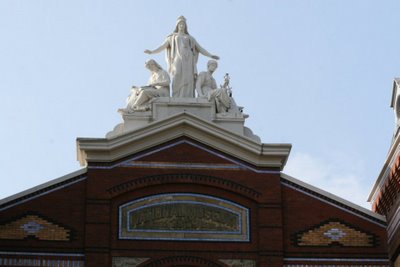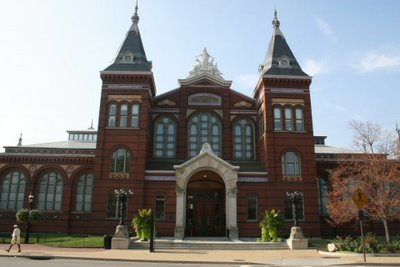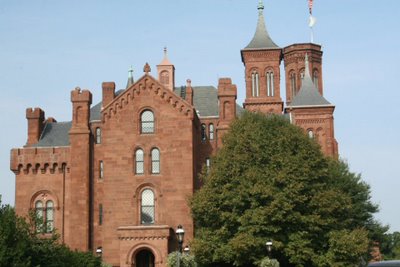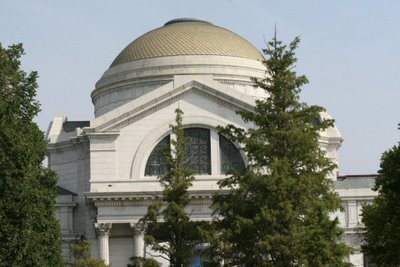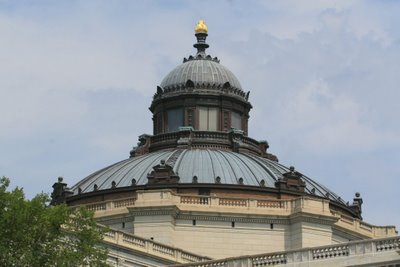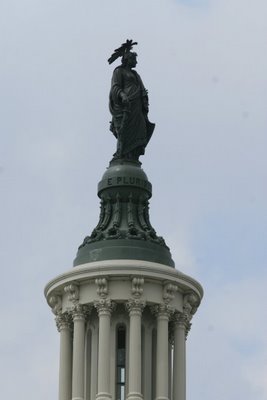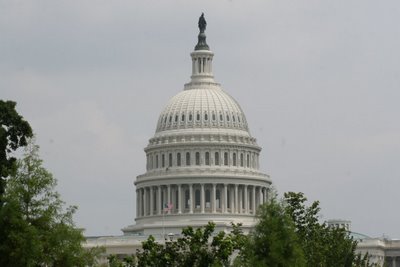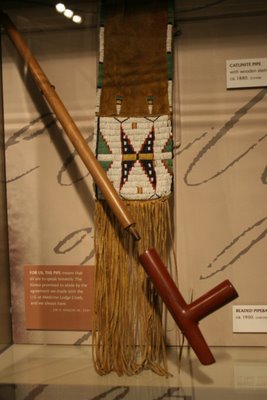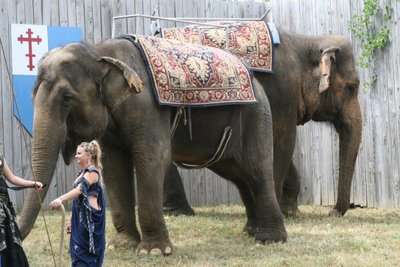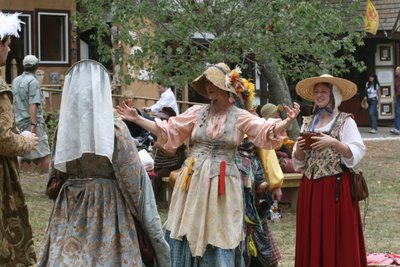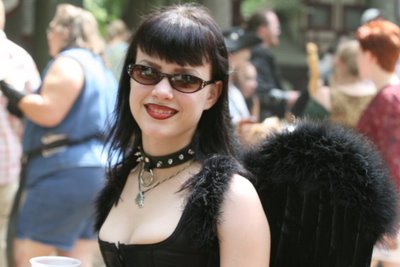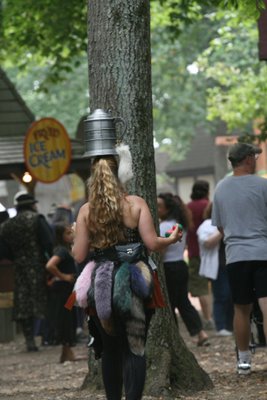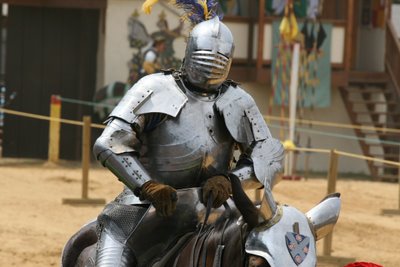Washington DC
Tuesday, August 29, 2006
The Library of Congress is the nation's oldest federal cultural institution and serves as the research arm of Congress. It is also the largest library in the world, with more than 130 million items on approximately 530 miles of bookshelves. The collections include more than 29 million books and other printed materials, 2.7 million recordings, 12 million photographs, 4.8 million maps, and 58 million manuscripts.
The Library's mission is to make its resources available and useful to the Congress and the American people and to sustain and preserve a universal collection of knowledge and creativity for future generations. The Office of the Librarian is tasked to set policy and to direct and support programs and activities to accomplish the Library's mission.
The Library of Congress occupies three buildings on Capitol Hill. The Thomas Jefferson Building (1897) is the original separate Library of Congress building. (The Library began in 1800 inside the U.S. Capitol.) The John Adams Building was built in 1938 and the James Madison Memorial Building was completed in 1981.
An agency of the legislative branch of the U.S. government, the Library includes several internal divisions (or service units), including the Office of the Librarian, Congressional Research Service, U.S. Copyright Office, Law Library of Congress, Library Services, and the Office of Strategic Initiatives.
The Library's Jefferson Building faces the Capitol of the United States on the First Street side. The Main Entrance to the building's first floor consists of three double, bronze entrance doors, weighing a total of 3 tons, depict Tradition, Writing and Printing (shown in the image on the right). They represent how history, religion, literature and science have been preserved and disseminated by man. The doors were modeled by Frederick MacMonnies, Olin L. Warner and Herbert Adams and are now opened only for special occasions.
After entering the building from these doors, or coming up one flight of stairs from the Ground Floor Visitors' Entrance, you will find yourself in the West Corridor of the Library's ornate Great Hall, also known as the Vestibule
The Library's mission is to make its resources available and useful to the Congress and the American people and to sustain and preserve a universal collection of knowledge and creativity for future generations. The Office of the Librarian is tasked to set policy and to direct and support programs and activities to accomplish the Library's mission.
The Library of Congress occupies three buildings on Capitol Hill. The Thomas Jefferson Building (1897) is the original separate Library of Congress building. (The Library began in 1800 inside the U.S. Capitol.) The John Adams Building was built in 1938 and the James Madison Memorial Building was completed in 1981.
An agency of the legislative branch of the U.S. government, the Library includes several internal divisions (or service units), including the Office of the Librarian, Congressional Research Service, U.S. Copyright Office, Law Library of Congress, Library Services, and the Office of Strategic Initiatives.
The Library's Jefferson Building faces the Capitol of the United States on the First Street side. The Main Entrance to the building's first floor consists of three double, bronze entrance doors, weighing a total of 3 tons, depict Tradition, Writing and Printing (shown in the image on the right). They represent how history, religion, literature and science have been preserved and disseminated by man. The doors were modeled by Frederick MacMonnies, Olin L. Warner and Herbert Adams and are now opened only for special occasions.
After entering the building from these doors, or coming up one flight of stairs from the Ground Floor Visitors' Entrance, you will find yourself in the West Corridor of the Library's ornate Great Hall, also known as the Vestibule
The United States Capitol is among the most symbolically important and architecturally impressive buildings in the nation. It has housed the meeting chambers of the House of Representatives and the Senate for two centuries. The Capitol, which was started in 1793, has been through many construction phases. It stands today as a monument to the American people and their government.
An example of 19th-century neoclassical architecture, the Capitol evokes the ideals that guided the Founding Fathers as they developed the new republic. Pierre Charles L'Enfant was expected to design the Capitol, but his dismissal in 1792 due to his refusal to cooperate with the Commissioners of the Federal Buildings, resulted in other plans. A competition was suggested by Secretary of State Thomas Jefferson and President George Washington that would award $500 and a city lot to whomever produced the winning plan by mid-July. None of the 17 plans submitted were satisfactory. In October, a letter arrived from Dr. William Thornton, a Scottish-trained physician living in the British West Indies, requesting an opportunity to submit his plan after the competition was closed. The Commissioners granted his request and President Washington commended the plan that was soon accepted by the Commissioners.
The cornerstone was laid by President Washington on September 18, 1793. Because of Thornton's inexperience, the initial work progressed under the direction of three architects in succession. Stephen H. Hallet and George Hadfield were dismissed because of inappropriate design changes they tried to impose; James Hoban, winner of the competition for the President's House, was placed in charge and saw to the completion of the north wing for the first session of Congress on November 17, 1800. In 1803, construction resumed under Benjamin Henry Latrobe who completed the south and north wings. By 1813, Latrobe, with his job done, departed with the wings connected by a temporary wooden passageway. Today, the Capitol covers a ground area of 175,170 square feet and has a floor area of about 16.5 acres. In addition to its use by Congress, the Capitol is a museum of American art and history. It stands as a focal point of the government's legislative branch and as a centerpiece of Capitol Hill and the National Mall
An example of 19th-century neoclassical architecture, the Capitol evokes the ideals that guided the Founding Fathers as they developed the new republic. Pierre Charles L'Enfant was expected to design the Capitol, but his dismissal in 1792 due to his refusal to cooperate with the Commissioners of the Federal Buildings, resulted in other plans. A competition was suggested by Secretary of State Thomas Jefferson and President George Washington that would award $500 and a city lot to whomever produced the winning plan by mid-July. None of the 17 plans submitted were satisfactory. In October, a letter arrived from Dr. William Thornton, a Scottish-trained physician living in the British West Indies, requesting an opportunity to submit his plan after the competition was closed. The Commissioners granted his request and President Washington commended the plan that was soon accepted by the Commissioners.
The cornerstone was laid by President Washington on September 18, 1793. Because of Thornton's inexperience, the initial work progressed under the direction of three architects in succession. Stephen H. Hallet and George Hadfield were dismissed because of inappropriate design changes they tried to impose; James Hoban, winner of the competition for the President's House, was placed in charge and saw to the completion of the north wing for the first session of Congress on November 17, 1800. In 1803, construction resumed under Benjamin Henry Latrobe who completed the south and north wings. By 1813, Latrobe, with his job done, departed with the wings connected by a temporary wooden passageway. Today, the Capitol covers a ground area of 175,170 square feet and has a floor area of about 16.5 acres. In addition to its use by Congress, the Capitol is a museum of American art and history. It stands as a focal point of the government's legislative branch and as a centerpiece of Capitol Hill and the National Mall





Listening to Our Ancestors explores how Native people along the coast of Washington State, British Columbia, and Alaska continue time-honored practices in an ever-changing modern world. The exhibition features more than 400 ceremonial and everyday objects, as well as commentary from representatives of eleven contemporary North Pacific Coast Native nations. The exhibition includes a wide variety of pieces, from intricately woven and ornamented dance blankets to halibut fishing hooks, finely carved and painted masks of supernatural creatures to spoons carved from the horns of mountain goats. Each object reflects the creativity of people whose art has been collected by museums worldwide for more than a century.
The jacket is made from the stomach of seals and it protects the fisherman from the ocean water. I have a facisnation with the masks of the North West Indians

Our Universes focuses on indigenous cosmologies—worldviews and philosophies related to the creation and order of the universe—and the spiritual relationship between humankind and the natural world. Organized around the solar year, the exhibition introduces visitors to indigenous peoples from across the Western Hemisphere who continue to express the wisdom of their ancestors in celebration, language, art, spirituality, and daily life.
The Vest was made using bird quills

How the Raven Stole the Sun
Long, long ago the world was completely dark. Raven, a very clever bird, knew that a family had taken the sun. They hid it in their lodge, in a bentwood box.
Raven had a plan to steal the sun back. He became a baby! When the family saw this cute little baby, they brought him into their home. But Raven began to cry all the time. He drove the family crazy with his strange wild screams. "What does he want?" they asked each other. Raven pointed to a beautifully carved cedar box in the corner of the lodge. Unable to bear his screaming, the family gave it to him.
As soon as no one was watching, Raven turned himself back into a bird. With a loud "Ca-aw!" he snatched up the box and flew out through the smoke-hole of the lodge. As he flew, Raven opened the cedar sun-box, and sunlight flooded the world.
- A Native American legend from the Pacific Northwest Coast




The National Museum of the American Indian is the sixteenth museum of the Smithsonian Institution. It is the first national museum dedicated to the preservation, study, and exhibition of the life, languages, literature, history, and arts of Native Americans. Established by an act of Congress in 1989, the museum works in collaboration with the Native peoples of the Western Hemisphere to protect and foster their cultures by reaffirming traditions and beliefs, encouraging contemporary artistic expression, and empowering the Indian voice.

